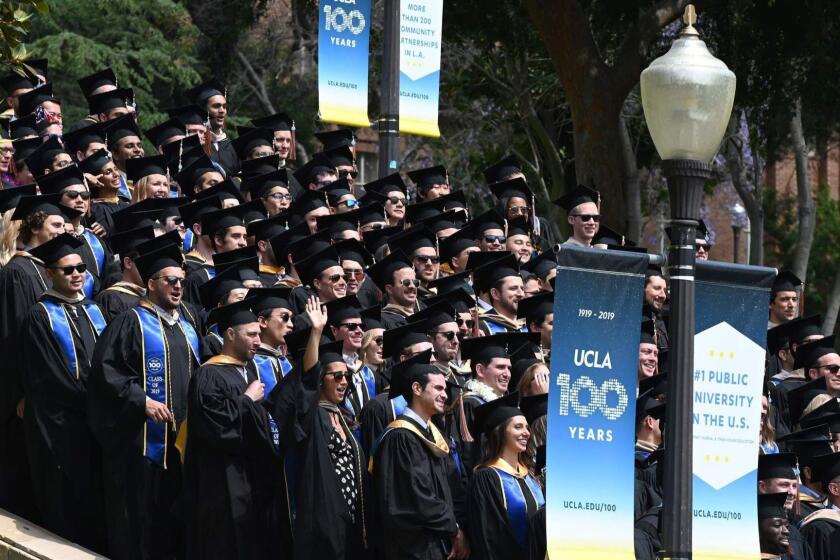UC notches a massive win in its quest to save scientific publishing
- Share via
The University of California, which has fought a years-long battle against the profiteering business model of scientific publishers, just scored a massive win: A four-year deal that will make the content of more than 2,700 journals published by Springer Nature available to UC virtually without subscription charges.
Instead, UC and its authors will pay a fee to Springer Nature once their articles are accepted for publication in those journals. The publication fees will largely substitute for the subscription fees UC formerly paid for Springer Nature journals, though the money may come from other sources, including research grants.
The new arrangement will allow anyone to read and use the published papers free of charge. The contract runs through 2023.
The agreement announced this week brings together the nation’s leading research university system and the world’s second-largest scientific and technical publisher. It’s a major step forward in the campaign by UC — as well as academic institutions throughout the U.S. and the world — to scrap the existing business model of for-profit academic publishers.
This is a big agreement. It demonstrates to the world that the open access publishing model that we’ve been promoting is feasible across all sizes of publishers, including large for-profit commercial publishers.
— Jeffrey MacKie-Mason, UC university librarian
In this campaign UC wields heavy firepower, as its the source of an estimated 10% of all U.S. generated research. The university accounts for about 2% of all the content published by Springer Nature journals.
But the university has been struggling to manage a subscription budget of some $50 million a year, according to Ivy Anderson, associate executive director of UC’s California Digital Library.
As subscription costs continued to rise inexorably, squeezing out resources for other services, UC, like other institutions, began to seek ways to get more value out of its spending while expanding the dissemination of its research.
Prior to this, UC reached open-access agreements with a number of smaller publishers, but none of Springer Nature’s scale.
Boiled down to dollars and cents, the battle between the University of California, the nation’s premier producer of academic research, and Reed Elsevier, the world’s leading publisher of academic journals, can seem almost trivial.
“This is a big agreement,” says University Librarian Jeffrey MacKie-Mason, who is also a Berkeley economics professor. “It demonstrates to the world that the open-access publishing model that we’ve been promoting is feasible across all sizes of publishers, including large for-profit commercial publishers.”
Traditionally, the publishers accept papers for publication for free but charge steep subscription fees. That model meant, in practice, that academic users incurred the cost of conducting their research and again to read their own papers in print or online. The model also erected a financial wall between authors and fellow scientists, who would also have to pay to read published papers.
The Springer Nature agreement effectively leaves the world’s largest scientific and technical publisher, Elsevier, by the wayside. UC has battled since 2018 to convert its $11-million subscription contract with Elsevier to the open-access model.
The two sides have been unable to reach agreement despite an extended game of brinkmanship. In March 2019, having failed to reach an agreement on open access, UC terminated its subscriptions to 2,500 Elsevier academic journals, including some of the most important publications in the world such as the Lancet and Cell.
Elsevier allowed UC faculty, students and staff to continue accessing the journals until mid-July, when it finally cut off their access to most new material. (Content from 2018 and earlier remained available.)
The conflict reflected Elsevier’s generally hard-ball approach to open-access demands, which have been spreading across the globe; users in Germany have been cut off, although the publisher has reached deals with users in the Netherlands, Sweden and some research universities restoring access that had been terminated while allowing some open-access rights.
You can think of it as a prizefight in the publishing super-heavyweight class.
An Elsevier spokeswoman called the Springer Nature deal “good news for researchers and the shared objective of open access being advanced.”
She said the deal “demonstrates what’s possible to achieve with the UC system as we continue our dialogue ... towards a sustainable solution.” UC says it is not currently negotiating a new contract with Elsevier, though the two parties have had continued “conversations.”
“We’ve been looking for some common ground so we can get to negotiations,” MacKie-Mason says.
In contrast to Elsevier, Springer Nature has proactively embraced the open-access model. That largely recognizes the model as the future of academic publishing in a world where financial constraints increasingly afflict academic institutions of all sizes.
“Open access is at the core of our strategy,” Carrie Webster, vice president of open access at the publisher, told me. “We’ve believed for a long time that it’s in the best interest of research. The open-access business model is a necessary step in getting to the open science future.”
UC, for its part, committed itself to open access in 2013, in recognition that it was inescapably the best path for “disseminating its research and scholarship as widely as possible.”
According to the memorandum of understanding released this week, UC authors will be able to publish their articles on an open-access basis in most Springer Nature journals.
The bitter battle between the University of California, a leading source of published research papers, and Elsevier, the world’s largest publisher of research papers, just got more bitter.
The arrangement doesn’t include at the outset Nature and Nature-branded journals, which Berlin-based Springer acquired in 2015 and which rank among the most prestigious scientific journals in the world. But the contract anticipates that those journals will be brought into the arrangement in 2022.
Meanwhile, UC will have permanent access to more than 2,200 journals published under the Springer, Palgrave, Adis and Macmillan imprints.
According to the arrangement, UC is expected to cover the first $1,000 of Springer’s article publishing charge per paper, with researchers contributing any excess from foundation grants or other sources. The university will cover the excess for researchers without sufficient wherewithal.
Researchers who prefer to publish under the traditional subscription model will be able to opt out of the open-access arrangement if they publish in Springer Nature journals that are “hybrids” — that is, accept papers on both models.
Overall, UC is expected to pay at least 5% less to Springer Nature in 2021 than it did under its previous contract. Anderson and MacKie-Mason declined to say how much the university was paying before, but said that it was less than the $11 million spent on Elsevier subscriptions and fees.
More to Read
Inside the business of entertainment
The Wide Shot brings you news, analysis and insights on everything from streaming wars to production — and what it all means for the future.
You may occasionally receive promotional content from the Los Angeles Times.













